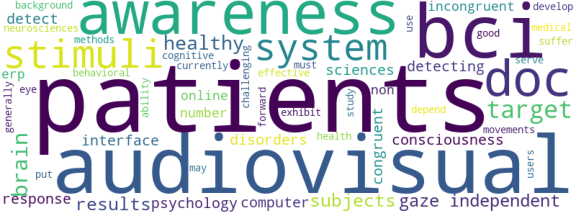| Id | 581 | |
| Author | Xie Q., Pan J., Chen Y., He Y., Ni X., Zhang J., Wang F., Li Y., Yu R. | |
| Title | A gaze-independent audiovisual brain-computer Interface for detecting awareness of patients with disorders of consciousness 17 Psychology and Cognitive Sciences 1701 Psychology 11 Medical and Health Sciences 1109 Neurosciences | |
| Reference | Xie Q., Pan J., Chen Y., He Y., Ni X., Zhang J., Wang F., Li Y., Yu R.; A gaze-independent audiovisual brain-computer Interface for detecting awareness of patients with disorders of consciousness 17 Psychology and Cognitive Sciences 1701 Psychology 11 Medical and Health Sciences 1109 Neurosciences ;BMC Neurology vol:18 issue: 1.0 page: |
|
| Link to article | https://www.scopus.com/inward/record.uri?eid=2-s2.0-85054638499&doi=10.1186%2fs12883-018-1144-y&partnerID=40&md5=345fe6a2294e46bb508d423ecb848644 |
|
| Abstract | Background: Currently, it is challenging to detect the awareness of patients who suffer disorders of consciousness (DOC). Brain-computer interfaces (BCIs), which do not depend on the behavioral response of patients, may serve for detecting the awareness in patients with DOC. However, we must develop effective BCIs for these patients because their ability to use BCIs does not as good as healthy users. Methods: Because patients with DOC generally do not exhibit eye movements, a gaze-independent audiovisual BCI is put forward in the study where semantically congruent and incongruent audiovisual number stimuli were sequentially presented to evoke event-related potentials (ERPs). Subjects were required to pay attention to congruent audiovisual stimuli (target) and ignore the incongruent audiovisual stimuli (non-target). The BCI system was evaluated by analyzing online and offline data from 10 healthy subjects followed by being applied to online awareness detection in 8 patients with DOC. Results: According to the results on healthy subjects, the audiovisual BCI system outperformed the corresponding auditory-only and visual-only systems. Multiple ERP components, including the P300, N400 and late positive complex (LPC), were observed using the audiovisual system, strengthening different brain responses to target stimuli and non-target stimuli. The results revealed the abilities of three of eight patients to follow commands and recognize numbers. Conclusions: This gaze-independent audiovisual BCI system represents a useful auxiliary bedside tool to detect the awareness of patients with DOC. © 2018 The Author(s). |
|
| Keywords | Audiovisual brain-computer interface (BCI); Awareness detection; Disorders of consciousness (DOC); Event-related potential (ERP); Semantic congruency |
Wordcloud:



